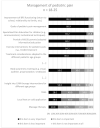Recommendations for a Pediatric Pain Education Curriculum for Physical and Occupational Therapists: Scoping Review and Survey
- PMID: 34068213
- PMCID: PMC8153113
- DOI: 10.3390/children8050390
Recommendations for a Pediatric Pain Education Curriculum for Physical and Occupational Therapists: Scoping Review and Survey
Abstract
Specialization training for physiotherapists, occupational therapists, and sports therapists involved in pediatric pain is scarce and curricula are rarely published. The objectives of this study are twofold: firstly, to perform a scoping review to derive important contents for a pediatric pain education curriculum for specialized pain therapists. Secondly, to conduct a survey on specific contents in curricula currently used by pain experts and to obtain their evaluation regarding the importance of such contents for a specialized curriculum. The review substantiated the importance of a specific curriculum in pediatric pain education, but provided little information on adequate contents. In the survey, 45 experts in pediatric pain education confirmed that specific curricula and specialized contents for pediatric pain education are missing. Their answers give a well-defined picture of the specifics needed in the interaction with a pediatric population. The most important items they classified were e.g., the biopsychosocial framework and the impact of pediatric pain on daily life. Those expert ratings were in line with the recommendations of pediatric pain management guidelines. Further curriculum work in an interdisciplinary, international network is highly recommended.
Keywords: curriculum; education; occupational therapists; pain; pediatrics; physical therapists; review; survey.
Conflict of interest statement
M.L., M.E.M. and K.K. developed and teach a postgraduate specialized pain physiotherapy training (based on the IASP Curriculum), which contains a 4-h pediatric pain module, through the German Pain Society. All authors declare no conflict of interest.
Figures






Similar articles
-
Exploring conceptual and theoretical frameworks for nurse practitioner education: a scoping review protocol.JBI Database System Rev Implement Rep. 2015 Oct;13(10):146-55. doi: 10.11124/jbisrir-2015-2150. JBI Database System Rev Implement Rep. 2015. PMID: 26571290
-
Integrative pediatric pain management: Impact & implications of a novel interdisciplinary curriculum.Complement Ther Med. 2021 Jun;59:102721. doi: 10.1016/j.ctim.2021.102721. Epub 2021 May 5. Complement Ther Med. 2021. PMID: 33964407
-
Training of Physical Therapists to Deliver Individualized Biopsychosocial Interventions to Treat Musculoskeletal Pain Conditions: A Scoping Review.Phys Ther. 2021 Oct 1;101(10):pzab188. doi: 10.1093/ptj/pzab188. Phys Ther. 2021. PMID: 34331758
-
The current state of pain education within Canadian physiotherapy programs: a national survey of pain educators.Disabil Rehabil. 2020 May;42(9):1332-1338. doi: 10.1080/09638288.2018.1519044. Epub 2019 Jan 8. Disabil Rehabil. 2020. PMID: 30620223
-
Acceptability of Pediatric Telerehabilitation Interventions Provided by Physical Therapists and Occupational Therapists-A Scoping Review.Phys Occup Ther Pediatr. 2022;42(6):615-634. doi: 10.1080/01942638.2022.2064203. Epub 2022 Apr 19. Phys Occup Ther Pediatr. 2022. PMID: 35440285
Cited by
-
Communicating with children about 'everyday' pain and injury: A Delphi study.Eur J Pain. 2022 Oct;26(9):1863-1872. doi: 10.1002/ejp.2008. Epub 2022 Jul 21. Eur J Pain. 2022. PMID: 35829711 Free PMC article.
-
Caregiver experiences and needs in pediatric rheumatic disease: a mixed-methods systematic review protocol.Syst Rev. 2025 Feb 26;14(1):48. doi: 10.1186/s13643-025-02788-1. Syst Rev. 2025. PMID: 40011976 Free PMC article.
References
-
- Eccleston C., Fisher E., Howard R.F., Slater R., Forgeron P., Palermo T.M., Birnie K.A., Anderson B.J., Chambers C.T., Crombez G., et al. Delivering transformative action in paediatric pain: A Lancet Child & Adolescent Health Commission. Lancet Child Adolesc. Health. 2021;5:47–87. - PubMed
-
- Stevens B.J., Abbott L.K., Yamada J., Harrison D., Stinson J., Taddio A., Barwick M., Latimer M., Scott S.D., Rashotte J., et al. Epidemiology and management of painful procedures in children in Canadian hospitals. CMAJ Can. Med. Assoc. J. 2011;183:E403–E410. doi: 10.1503/cmaj.101341. - DOI - PMC - PubMed
Publication types
LinkOut - more resources
Full Text Sources

